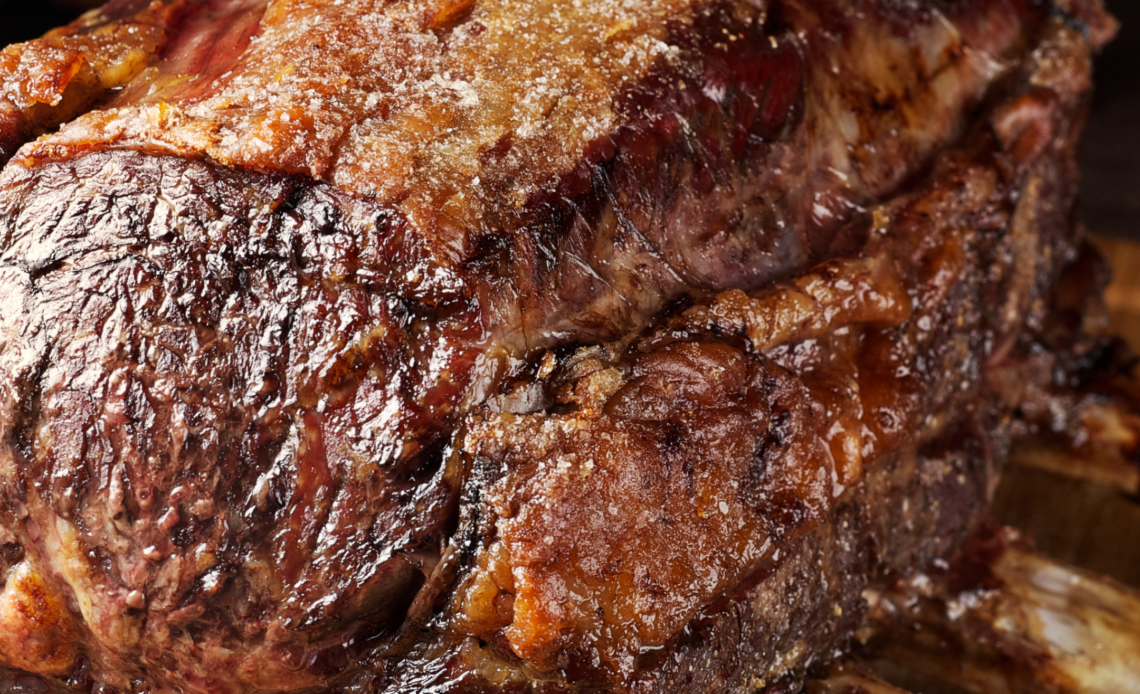
The standing rib roast is considered by many to be the best roast beef in the world. Also known as prime rib, this beef is juicy and full of flavor. This recipe uses a safe, simple, yet highly effective roasting method that gives the beef a pink color throughout. To continue, pull out the beef before the target internal temperature and go from medium-rare to medium. Otherwise, it will boil while resting.

Standing Rib Roast – don’t make this mistake!
The biggest mistake people make with prime rib is not considering continuing to cook it while the beef is resting. So if he comes out of the oven at 52°C/125°F, the target temperature for medium rare, he will rise above 55°C/130°F when rested. This is medium. That is, there is not much brushing pink left!
Therefore, the beef should be removed from the oven before reaching the target temperature. Here is a graph of the internal temperature of prime rib at various levels of doneness.
Prime Rib – simply the best
Definitely – standing ribeye is creme de la crème in a roast. Also known as “prime rib”, it is THE roast beef that combines flavor, texture and juiciness superior to any other cut.
Certainly not an economical cut. It’s a worthwhile investment for special occasions, as it brings together like-minded people who cherish the moment of slicing through a deep golden garlic-encrusted crust. Clap… your hands know it will taste incredibly succulent…..
Get ready for the ultimate roast beef experience – with a sumptuous red wine sauce, parish puree and spinach. Serve with sautéed garlic!!
Safe, highly effective cooking method
20 minutes in a hot oven, then 1.5 hours in a low oven. This will give you a roast that cooks evenly to your chosen doneness (medium rare for me!) and has a deep golden crust.
This method is safe and very effective and has the advantage of slow cooking for a long time, but it cooks much faster.
Low temperature roasting is better than hard & fast pressure roasting. Because it cooks evenly throughout (the outer ring doesn’t overcook!), there is less risk of overcooking and the fat melts, making the meat even juicier.
How to choose the best standing rib roast
United States – If you live in the United States, the USDA makes it easy to evaluate prime rib. The order is Prime (highest), Choice, and Select. Classification is basically based on fat marbling and taste.
We don’t have a consistent rating system here in Australia. But what I can say for sure is if you want a quality standing rib roast, skip the supermarket and go to your local butcher.Whether it’s grass-fed or grain-fed is a personal choice.
Grain rations generally have better marbling resulting in a richer, fuller flavor. Grass-fed is usually lower in fat, but people (myself included!) believe beef tastes richer, has a richer flavor, and the meat is more tender. For meat, I recommend his dry aged beef. You pay a lot for it – but it’s worth it!
Recipe pictured above and below The standing rib roast used in the video was cooked the way we do it here in Australia.
The Foil: Some butchers sell standing prime rib roast with foil wrapped around the bone. For presentation purposes only, to prevent the bones from turning brown. Dark brown skin, pink flesh, and white bones are impressive. Leave it alone when adding the beef. But I don’t do it myself.
How the beef is cut – Bone in / off / tied back on
This recipe works well whether bone-in, bone-in, or tied. The idea of roasting ribs never crossed my mind.
Plus – I love it on the bone! And wouldn’t it be best to chew the meat off the bone?
In the US you can find butchers who will remove the bones and then re-tie them. Here in Australia you have to ask for a special order to cut the bones.
The meat itself is incredibly juicy (with garlic herb butter for good measure!). Use what you have available or use your personal preference.
Ingredients you need
When you invest in a good piece of beef, you don’t need to do much to it.
But then again, a good slathering of Herb and Garlic Butter certainly doesn’t do any harm!
Using softened rather than melted butter works much better because the garlic and herb bits stick to the skin, creating a terrific golden herb and garlic crust!
Feel free to switch the herbs to what you have / prefer. Also, dried herbs work too!
How to make standing rib roast
After buttering the beef, reheat in a hot oven for 20 minutes to bake the crust, then roast in a relatively low oven at 120°C/250°F for an additional 1.5 hours, then let stand for 20-30 minutes. .
In this method, the high temperature rapidly forms a crust that traps the juice. Then reduce the heat to a slow, even roast, giving the beef an overall pink color rather than thick, overcooked bands on the outside.
Internal temperature he aims for 50°C / 122°F when removed from oven (medium rare, recommended) and after resting he raises to 54°C / 129°F for perfect medium . See table below for other doneness.
There are “there” recipes that choose even lower temperatures and roasting times of up to 10 hours. to form a thin black bark.
I actually like the texture contrast of the thin layer of cooked beef on the outer edge of the beef. Still 90% pink and baked all over medium rare!
Never skip the 20 minute rest, essential to let the meat juices redistribute. If you don’t rest, the meat juice will run everywhere when you slice it = not as juicy.
Target internal temperature
Remember, as I explained at the very top, pull the beef out of the oven before your final Target Temperature as the internal temperature will continue to rise at it rests for 20 minutes. If you pull the beef out of the oven when it is already medium rare (52°C / 125°F), it will be medium after it rests – barely any blushing pink left!
The Target Temp is the final internal temperature for each level of doneness. The Pull Temp is the temperature at which the beef should be pulled out of the oven. It will rise to the Target Temp after resting for 20 minutes.
Why I roast on a bed of onion, garlic & herbs
I like to roast my standing rib on a bed of onion, garlic and herbs which serves three purposes:
- Elevates the beef off the base to encourage more even cooking;
- Stops the drippings from burning (smokes out oven + can’t make a sauce from drippings); and
- Adds more flavour to the drippings that is then used to make a sauce for the prime rib.
Key tip: take out of fridge 2 hours prior
Standing rib loin is an impressive cut of meat. I like to take it out of the fridge 2 or 3 hours before cooking to expedite cooking. Prevent the beef from heating until you have small circles of pink, fully cooked beef in the pan.
Sauce for Prime Rib – Red Wine Sauce
The beef tallow left in the pot is full of umami, so please use it as a sauce!
Red wine and beef are a classic flavor combination, so I chose this one. Basically, beef broth and red wine are boiled down in the same pan the beef was fried to a very hearty sauce with intense flavor to create red wine juice.
I like a thicker sauce, so I add some cornstarch to thicken it up. But that’s optional – most red wine juices are not thick and are fairly thick sauces.
What to serve with Prime Rib
For a high-end restaurant experience, you can’t go past Paris Mash(pictured below) – ultra rich and creamy mashed potato! Potatoes au gratin is an elegant French potato side option that’s ideal for making ahead. Otherwise, rich and creamy Cauliflower Cheese is a British roast dinner classic! For greens, Garlic Sautéed Spinach pairs exceptionally well with Prime Rib and is a Classic Steakhouse side!
Here are a few more options:
Just imagine that moment, when you carve up thick slices of this Standing Rib Roast that’s almost impossibly juicy, blushing pink on the inside with that salty, buttery, herb and garlic crust….
It’s so unbelievably tender, and it’s so perfect you know you could eat the whole thing plain…. But THEN, you add a drizzle of that incredible Red Wine Sauce…..

